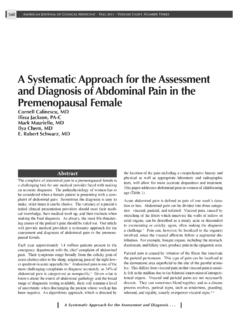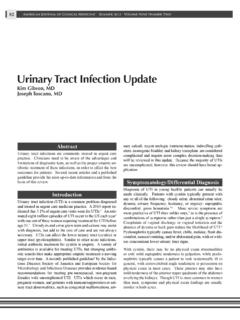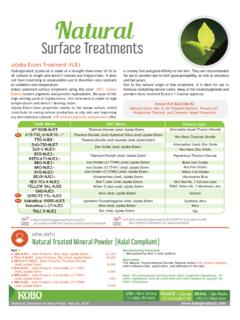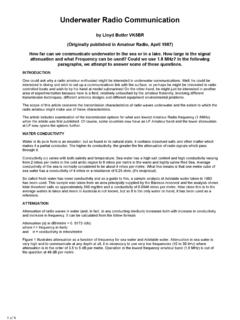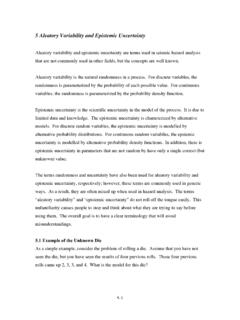Transcription of Epidemics After Natural Disasters
1 American Journal of Clinical Medicine Fall 2011 Volume Eight, Number Three144 AbstractEpidemics of infectious disease are rare following Natural di-sasters, especially in developed countries. Observations from previous Natural Disasters suggest that skin, diarrheal, and re-spiratory infections are the most common infectious diseases in survivors. The etiologies of disease outbreaks are usually pre-dictable, reflecting infectious diseases endemic in the affected area before the disaster . Injury and soft tissue infections are expected during the first few days After a disaster . In contrast, airborne, water-borne, and food-borne diseases are anticipated for up to one month After a disaster .
2 A feared consequence of Natural Disasters is the potential exposure to dead bodies, both human and animal. No evidence exists that exposure to bodies After a disaster leads to infectious disease Epidemics . To be dis-cussed are specific Epidemics that have followed earthquakes, floods, tornadoes, tsunamis, volcanic eruptions, landslides, and drought. Preventative public health and safety measures aimed at attenuation of such Epidemics will be disaster has been defined as a result of a vast ecological breakdown in the relation between humans and their environ-ment, a serious or sudden event on such a scale that the stricken community needs extraordinary efforts to cope with it, often with outside help or international aid.
3 1 Such Disasters may be Natural Disasters , transportation Disasters , the result of terrorism or technological events, and pandemics. This article will focus on Epidemics following Natural Disasters . Such Disasters include earthquakes, floods, tornadoes, tsunamis, volcanic eruptions, landslides, and misunderstanding surrounds the potential for commu-nicable diseases After Disasters , with a widely held belief that Epidemics are inevitable. This is partially due to an overestima-tion of the capacity for disease spread from dead In fact, the primary driver of disease spread After Natural Disasters is population displacement and crowding and its interplay with endemic disease and with a breakdown in infrastructure.
4 If a disease is not endemic to a disaster area and is not introduced After a disaster , then it won t cause an epidemic After the Factors contributing to disaster severity include human vulnera-bility due to poverty and social inequality, environmental degra-dation, and rapid population growth, especially among the Disasters have killed millions of people over the last twenty years, impacting the lives of at least one billion more people, and resulting in enormous economic In the decade 1994-2004, there were approximately one million thunderstorms, 100,000 floods, tens of thousands of landslides, earthquakes, wildfires and tornadoes, and several thousand hur-ricanes, tropical cyclones, tsunamis, and Table 1 shows the relative risk of communicable diseases following specific developing countries may lack resources, infrastruc-ture, and disaster -preparedness systems, they may be dispro-portionately affected by Natural of Natural Disasters include an impact, post-impact, and The impact phase occurs from 0-4 days, during which extrication of victims and treatment of immediate soft tissue infections takes place.
5 Hypothermia, heat, illness, and dehydration are characteristic of this phase. In the post- impact Epidemics After Natural DisastersDavid M. Lemonick, MD, FAAEP, FACEPB ased on a presentation at the 2011 AAPS Annual Scientific Meeting, Tysons Corner, VA, June 21-22 American Journal of Clinical Medicine Fall 2011 Volume Eight, Number Three145phase, which takes place from four days to four weeks post-di-saster, airborne, foodborne, waterborne, and vector diseases are seen. Examples of diseases in this phase are cholera, bacterial dysentery, cryptosporidiosis, rotavirus, norovirus, salmonella, typhoid and paratyphoid, giardiasis, hepatitis A and E, and lep-tospirosis. Communicable respiratory infections in post-disas-ter settings include viral ( , influenza, RSV, adenoviruses), bacterial ( , Strep pneumoniae, pertussis, tuberculosis, Le-gionella, Mycoplasma pneumoniae), and diseases transmitted via the respiratory route ( , measles, varicella, nisseria men-ingitides).
6 Tetanus is also seen in this 1: Risk of communicable diseases After Disasters , by mode of transmission1 disaster TYPEPERSON-TO- PERSON*WATER-BORNE#FOOD-BORNE+VolcanoMed iumMediumMediumEarthquakeMediumMediumMed iumHurricaneMediumHighMediumTornadoLowLo wLowHeat waveLowLowLowCold waveLowLowLowFloodMediumHighMediumFamine HighHighMediumAir pollutionLowLowLowIndustrial accidentLowLowLowFireLowLowLowRadiationL owLowLowCivil war/ refugeesHighHighHigh*Shigellosis, streptococcal skin infections, scabies, infectious hepatitis, pertussis,measles, diphtheria, other respiratory infections, giardiasis, HIV/AIDS, othersexually-transmitted diseases, meningococcal disease, plague.#Typhoid and paratyphoid fevers, cholera, leptospirosis, infectious hepatitis, shigellosis, campylobacter, salmonella, E.
7 Coli, cryptosporidiosis.+ Typhoid and paratyphoid fevers, cholera, infectious hepatitis, shigellosis,campylobacter, salmonella, E. coli, amebiasis, giardiasis, recovery phase begins After four weeks, and diseases with long incubation periods, vectorborne, and chronic diseases manifest in this phase. Examples of organisms with long incu-bation periods are leishmaniasis and leptospirosis. Vectorborne illnesses include malaria, western/Saint Louis encephalitis, dengue, yellow fever, and West Nile virus. Chronic diseases seen in the recovery phase After hurricane Katrina, for example, included cardiac disease, hypertension, diabetes, and asthma. Special needs for shelters, wheelchairs, oxygen, large cots for the obese, glucometers, access to dialysis, and lacking prescrip-tion medications were also infections among survivors of the 2004 tsunami in Southeast Asia were polymicrobial, with over 600 organ-isms ultimately identified.
8 Most prominent among these were Aeromonas species, , Klebsiella pneumonia, and Pseu-domonas aeruginosa. Some of these organisms were resistant to all licensed Among hurricane evacuees from the New Orleans area, a cluster of infections with methicillin-resis-tant Staphylococcus aureus (MRSA) was reported in approxi-mately 30 pediatric patients at one evacuee facility in Dallas, Additionally, 24 cases of hurricane-associated Vibrio vulnificus and V. parahaemolyticus wound infections were re-ported, with six the factors that contribute to disease transmission After Disasters are environmental considerations, endemic organisms, population characteristics and crowding, the pre-event structure and type of public health systems and facilities and levels of immunization, and the magnitude of the disaster Envi-ronmental considerations include climate, with cold conditions favoring airborne pathogens and warm conditions favoring wa-terborne pathogens.
9 In temperate climates, the winter is as-sociated with influenza, while summer is a time for enterovi-rus infections. Similarly, rainfall during El Nino contributes to malaria, while drought leads to malnutrition-related disease. Geography may play a role in Epidemics by isolating victims from needed resources. Organisms endemic to a region will be present After the disaster , while those that are not endemic before the event are unlikely to be present afterwards. On the other hand, as was demonstrated with the appearance of Vibrio infections After hurricane Katrina, the lack of reports of an or-ganism prior to a disaster does not guarantee that the organism is not This phenomenon was also demonstrated by the appearance of enterotoxicogenic Shigella dysenteria type 1, Neisseria meningitidis, and hepatitis E, following Disasters in As happened in Haiti with cholera, introduction of non-endemic organisms is possible when relief workers carry it to a disaster area.
10 In fact, cholera has emerged as a seri-ous disease in Latin America only in recent Examples of endemic disease outbreaks to a region will be present After the disaster , including a nine-fold increase in coccidiomycosis (Valley fever) from January- March 1994 After the Northridge, California, earthquake and the giardiasis outbreak in 1980 After the eruption of Mount St. Helens, characteristics include the density and age of vic-tims and the preponderance of chronic diseases. Displaced populations may be crowded in refugee camps. Disease inci-dence is usually increased in the elderly and in the very young. Baseline immunity to specific diseases is another critical fea-ture of populations.
